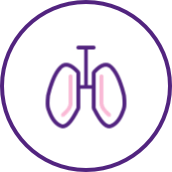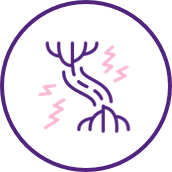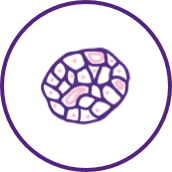Research and Development
Vertex is focused on discovering, developing and producing innovative medicines so people with serious diseases can lead better lives. Our scientists don’t see the impossible as an obstacle; they see it as a good place to start.
We have a unique way of building our drug discovery programs to maximize their chances of creating therapies that may dramatically improve patients’ lives. Our focus is on serious diseases where we could truly have a transformative impact for patients, not just an incremental benefit.
We work only on projects where we have a deep understanding of the underlying cause of disease in humans. Then we research and develop therapeutic approaches that are most likely to succeed. Rather than looking for problems we can solve with only the tools we’ve used before, we figure out the problems that need to be solved for the diseases we’re going after and invent the tools to potentially fix them.

Vertex is focused on discovering, developing and producing innovative medicines so people with serious diseases can lead better lives. Our scientists don’t see the impossible as an obstacle; they see it as a good place to start.
We have a unique way of building our drug discovery programs to maximize their chances of creating therapies that may dramatically improve patients’ lives. Our focus is on serious diseases where we could truly have a transformative impact for patients, not just an incremental benefit.
We work only on projects where we have a deep understanding of the underlying cause of disease in humans. Then we research and develop therapeutic approaches that are most likely to succeed. Rather than looking for problems we can solve with only the tools we’ve used before, we figure out the problems that need to be solved for the diseases we’re going after and invent the tools to potentially fix them.

Cystic fibrosis
Cystic fibrosis (CF) is a rare, chronic and life-shortening genetic disease. It’s a progressive, multi-system disease that affects the lungs, liver, gastrointestinal tract, pancreas, sinuses, sweat glands and reproductive tract. In the lungs, this leads to the build-up of abnormally thick, sticky mucus that can cause chronic lung infections and inflammation, resulting in progressive lung damage and premature death in many people with CF. Other complications can include malabsorption and failure to thrive due to pancreatic disease, diabetes, liver disease, bone disease or osteoporosis, depression and anxiety.

Pain
While pain can happen anywhere and anytime, it is a potentially debilitating condition that develops from a variety of pathophysiological and psychological conditions. It can be acute or chronic and range in severity. Some common causes of pain include arthritis, neuropathies, operations, musculoskeletal injuries, etc.
Poorly managed pain can lead to a significant decrease in quality of life and is often associated with complications such as sleep interruption, immobility, inability to work and major depression.

Sickle cell disease
Sickle cell disease (SCD) is an inherited blood disorder that affects the red blood cells, which are essential for carrying oxygen to all organs and tissues of the body. SCD causes severe pain, organ damage and a shortened life span due to misshapen or “sickled” blood cells People with SCD can experience painful blood vessel blockages, also known as vaso-occlusive crises (VOCs), that can lead to acute chest syndrome, stroke, jaundice and symptoms of heart failure. Individuals may also experience anemia, which can result in end-organ damage and premature death. VOCs are the hallmark of SCD, often resulting in severe and debilitating pain.
SCD requires lifelong treatment and significant use of health care resources, and ultimately results in decreased quality of life, reduced life expectancy and reduced lifetime earnings and productivity.

Beta thalassemia
Beta thalassemia is an inherited blood disorder that affects the red blood cells, which are essential for carrying oxygen to all organs and tissues of the body. A lack of red blood cells, also known as anemia, is the primary manifestation of beta thalassemia. Because of this anemia, people living with beta thalassemia may experience fatigue and shortness of breath, and infants may develop failure to thrive, jaundice and feeding problems. Complications of beta thalassemia can also include an enlarged spleen, liver and/or heart; misshapen bones; and delayed puberty.
Beta thalassemia requires lifelong treatment and significant use of health care resources, and ultimately results in reduced life expectancy, decreased quality of life and reduced lifetime earnings and productivity.

APOL1-mediated kidney disease
APOL1-mediated kidney disease (AMKD) is a genetic kidney disease associated with certain variants of the APOL1 gene, which exert a toxic effect on kidney cells, leading to cell injury, cell death, and damage to glomeruli (which filter blood to the kidney). This damage leads to loss of protein in the urine and deteriorating kidney function. This can cause a number of symptoms, including fatigue, swelling in the legs and feet, and weight gain.
Even with the current standard of care, people with AMKD often progress to kidney failure. Kidney failure is treated with frequent, long-term dialysis or a kidney transplant. Both require lifelong treatment and follow-up and carry a high mortality risk.

Type 1 diabetes
Type 1 diabetes (T1D) is a lifelong disease caused by the autoimmune destruction of insulin-producing islet cells (beta cells) in the pancreas. Insulin is a hormone that the body needs to process glucose, a key source of energy. Without insulin, no cell in the body can use or store glucose normally. The destruction of islet cells leads to a loss of insulin production and abnormal glucose (blood sugar) regulation, often leading to high glucose levels in the blood, known as hyperglycemia. Due to these high blood sugar levels, people with T1D develop symptoms including increased thirst or hunger, frequent urination and unexplained weight loss. Unable to use blood glucose for energy, the body will attempt to compensate by breaking down muscle and fat, leading to muscle wasting and the buildup of ketones in the blood, which becomes toxic. This can result in diabetic ketoacidosis, which may lead to death.
![]()
Myotonic dystrophy type 1
Myotonic dystrophy type 1 (DM1) is a debilitating, multisystemic, genetic disease that presents with a spectrum of disease severity. DM1 affects skeletal muscle, the heart, lungs and several other body systems. Muscle weakness, muscle wasting and myotonia (sustained muscle contraction and difficulty relaxing muscles) are the hallmark features of the disease with respiratory failure and cardiac abnormalities being the leading causes of early death in these patients.


